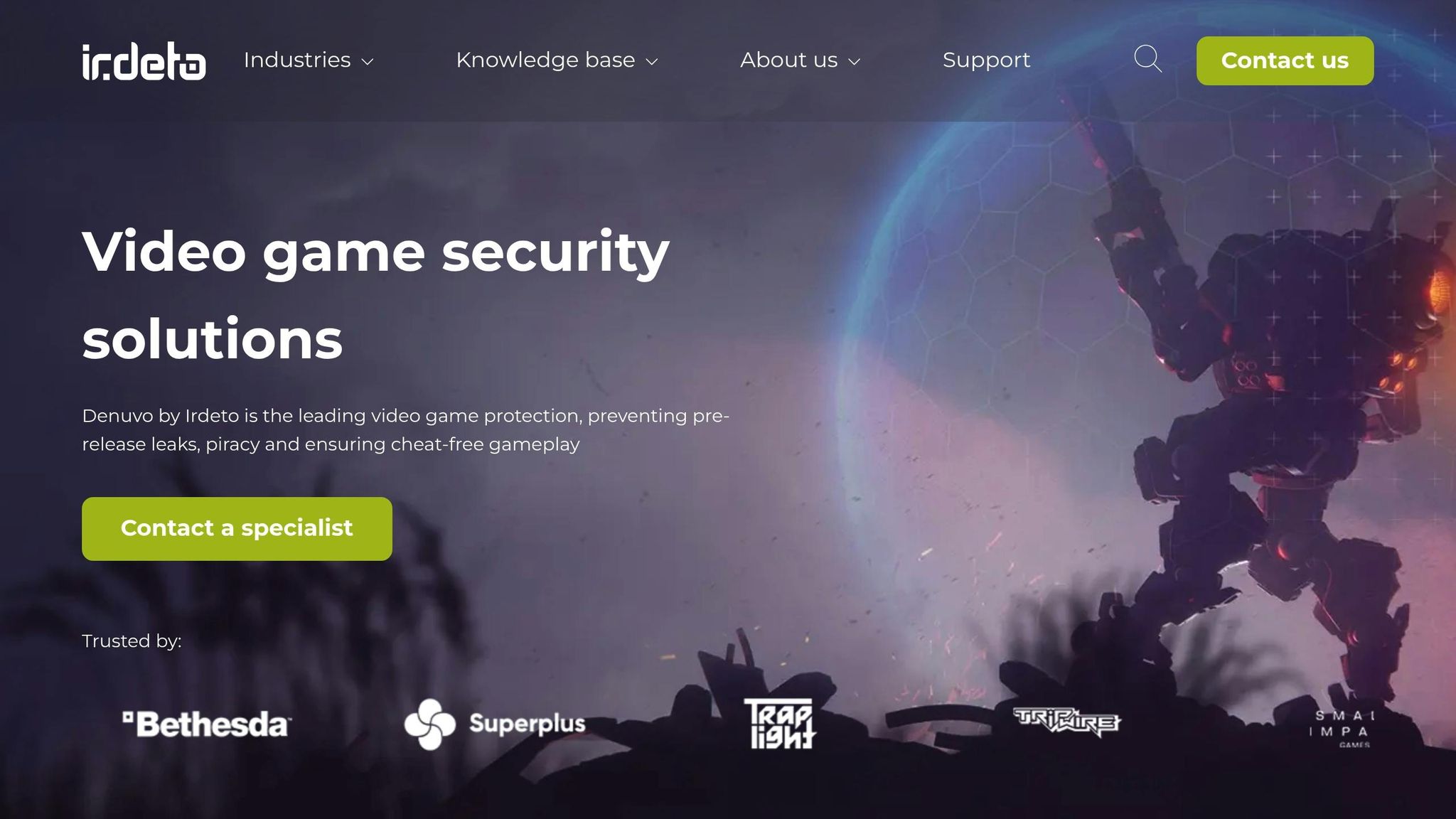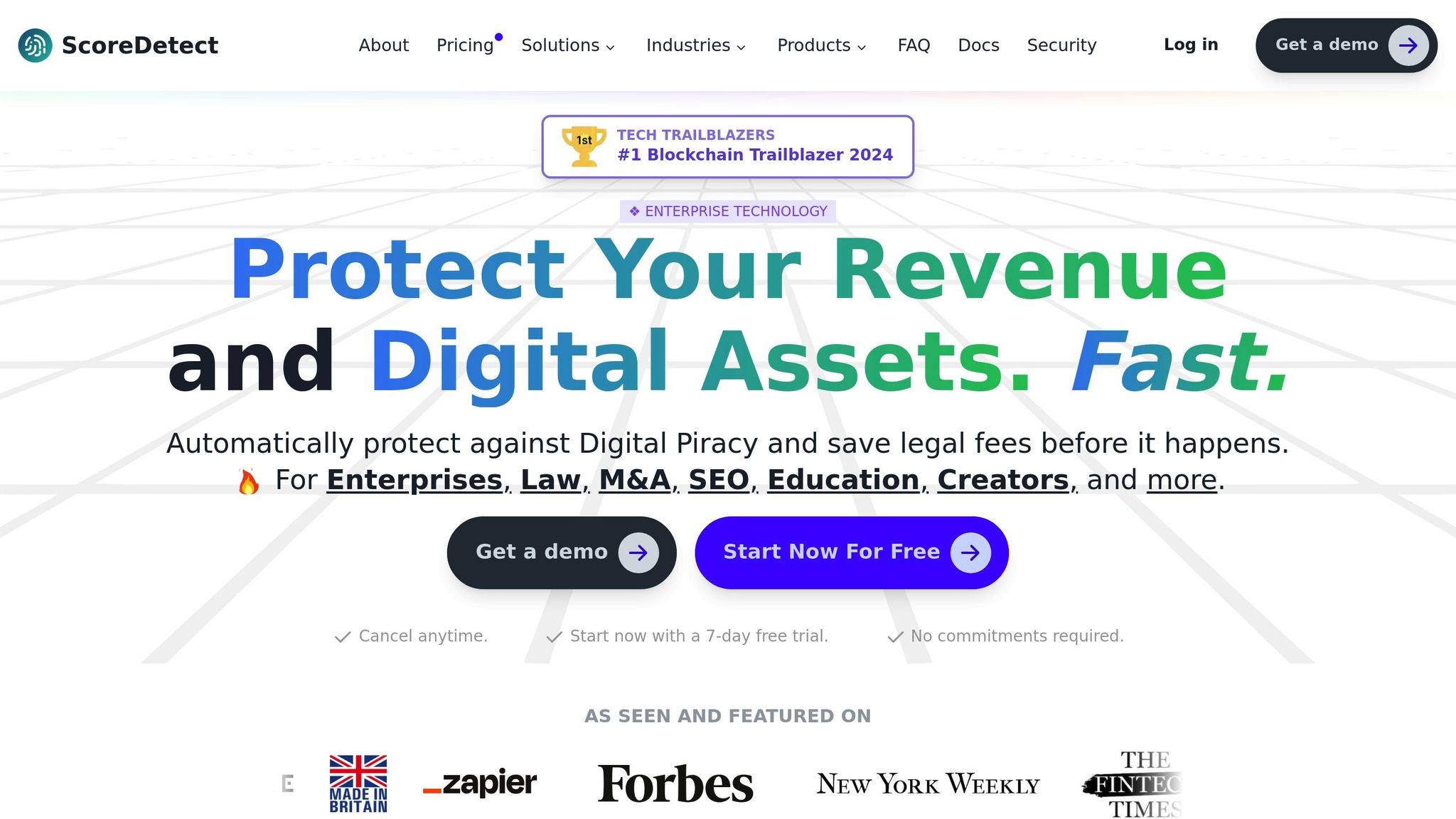Gaming piracy is a growing problem, causing financial and reputational harm to developers. To combat this, two primary tools are used: DRM (Digital Rights Management) and watermarking. DRM prevents access to games by unauthorized users, while watermarking identifies and traces pirated copies after distribution.
Key Highlights:
- DRM: Blocks access upfront using methods like online activation, account-based licenses, and hardware binding. It’s effective during a game’s initial release but can be bypassed by skilled attackers. It may also impact user experience due to performance issues or always-online requirements.
- Watermarking: Embeds invisible identifiers in game assets, allowing developers to track pirated copies and identify the source. It works silently without disrupting gameplay but doesn’t prevent initial piracy. Advanced tools like ScoreDetect automate piracy detection and takedown processes with high success rates.
Choosing the Right Approach:
- Use DRM to protect early sales, especially for high-profile releases.
- Opt for watermarking for long-term tracking and legal enforcement.
- Combining both methods provides stronger protection, addressing piracy at multiple stages.
Quick Comparison:
| Feature | DRM | Watermarking |
|---|---|---|
| Purpose | Blocks access | Tracks pirated copies |
| Impact on Players | Can be intrusive | Invisible to users |
| Implementation Cost | Higher | Lower |
| Effectiveness | Prevents access upfront | Detects piracy after it occurs |
| Legal Use | Limited forensic use | Strong evidence in disputes |
Both DRM and watermarking have strengths and weaknesses. A combined approach can safeguard games more effectively while balancing security and player experience.
How DRM Works in Gaming
DRM Technology Explained
DRM (Digital Rights Management) technology plays a key role in securing games by ensuring that only users with legitimate licenses can access and play them. It achieves this through methods like online activation, account-based access, hardware binding, and cloud authentication. Essentially, DRM systems verify ownership before granting access, helping to curb unauthorized use.
For example, when you buy a game on Steam, it’s tied directly to your account. Every time you launch the game, Steam verifies your credentials to ensure you’re the rightful owner. Similarly, hardware-based DRM links game licenses to specific device IDs. A practical example of this is the Nintendo Switch 2, which uses unique ID codes embedded in game cards to prevent piracy and emulation. Some physical games for the console come as "Game-Key Cards." These cards hold only a digital license, meaning you need to download the game files but still insert the physical card to play [3].
PlayStation Network takes a hybrid approach by combining online verification, account-tied content licenses, and hardware checks to limit unauthorized sharing [1][2]. Xbox Live employs a similar strategy, requiring periodic internet connections to validate digital licenses [1][2].
Cloud-based DRM adds another layer of security by storing sensitive information on remote servers. This approach not only strengthens protection but also offers greater flexibility for developers and publishers [1]. Together, these measures restrict unauthorized access and help safeguard revenue streams.
DRM Benefits
One of DRM’s primary advantages is its ability to protect revenue by deterring piracy, especially during critical sales periods. For instance, in 2025, Denuvo became a standard anti-tamper solution for most games, including Red Dead Redemption. This technology is particularly valuable during a game’s initial release window, a time when sales are at their peak. However, even the most robust DRM systems face ongoing challenges from skilled crackers.
DRM Drawbacks
Despite its strengths, DRM is not foolproof. In 2022, Denuvo was implemented in Nintendo Switch games to prevent PC emulation. Yet, determined crackers still found ways to bypass these protections [1]. This persistent issue highlights the need for additional measures, such as watermarking, which focuses on detecting and enforcing ownership rather than solely preventing piracy. While DRM can be effective, it’s clear that no single solution is entirely immune to circumvention.
Denuvo Tracemark

Watermarking for Gaming Content
While DRM focuses on controlling access, watermarking adds an extra layer of protection by embedding unique identifiers directly into game content.
Gaming Watermark Types
Watermarking in gaming comes in several forms, each tailored to specific needs:
- Visible watermarks: These are the most noticeable, often appearing as logos or text overlays on gameplay footage. You’ll frequently see them in gaming streams or beta versions, where developers want to make ownership clear.
- Invisible watermarks: Unlike visible marks, these are embedded within the game content itself and remain undetectable to players. They’re particularly effective for tracking unauthorized distribution without interfering with the gaming experience.
- Forensic watermarking: This method assigns a unique identifier to each distributed copy of a game. If leaked content appears online, forensic watermarks can trace it back to the original buyer or distribution channel, making it invaluable for identifying the source of leaks.
- Client-side watermarking: These watermarks are applied during gameplay or when content is created, such as recording gameplay videos or taking screenshots. They help developers monitor how their content spreads across platforms like YouTube or Twitch.
Each type of watermark plays a role in combating piracy and contributes to a broader strategy for content protection.
Watermarking Benefits
The standout advantage of watermarking is its ability to trace pirated content. If unauthorized copies of a game surface online, embedded watermarks provide a digital trail that points directly to the source of the leak. This forensic evidence is particularly useful in legal cases, helping developers take action against individuals or platforms responsible for piracy.
Another benefit is that watermarking works quietly in the background, ensuring gamers enjoy uninterrupted play. Unlike DRM systems that require constant authentication or internet access, watermarks don’t interfere with the gaming experience.
From a legal standpoint, watermarked content strengthens copyright claims. Courts often accept it as clear proof of ownership, simplifying the process of securing takedown orders or pursuing damages.
Advanced systems like ScoreDetect take this a step further, combining invisible watermarking with automated takedown capabilities. These systems boast impressive success rates, detecting unauthorized content 95% of the time and achieving a 96% takedown rate.
Watermarking also helps developers protect revenue. By tracking how content is shared and identifying unauthorized distribution channels, studios can better understand piracy trends and refine their strategies to combat it.
Watermarking Limitations
Despite its advantages, watermarking has limitations. For one, it doesn’t prevent initial access. Unlike DRM, which blocks unauthorized users from playing games, watermarks only come into play after content has been copied or distributed. This reactive approach means piracy can occur before detection.
Sophisticated attackers can sometimes remove watermarks using advanced techniques like signal processing, compression, or content manipulation. While this requires significant technical skill, it’s not impossible for determined individuals to bypass protections.
Performance can also take a hit, particularly in resource-heavy games. Although modern watermarking systems aim to minimize impact, older hardware or mobile devices might experience slower frame rates or longer loading times.
False positives are another concern. Legitimate content sharing, fair use scenarios, or technical glitches can trigger detection systems incorrectly. This could lead to unnecessary takedown requests, potentially affecting authorized users or content creators.
Finally, cost can be a barrier, particularly for indie developers with limited budgets. While large studios can absorb the expense of implementing robust watermarking systems, smaller teams might find it harder to justify the investment. Balancing these costs against the benefits is essential when deciding between watermarking and DRM.
sbb-itb-738ac1e
DRM vs Watermarking Comparison
When comparing DRM and watermarking, their distinct roles become clear: DRM focuses on blocking unauthorized access, while watermarking helps trace piracy after it happens.
Side-by-Side Feature Comparison
The key difference lies in their timing and purpose. DRM acts as a gatekeeper, restricting access from the start. On the other hand, watermarking operates discreetly, helping identify and trace unauthorized distribution after it occurs. Here’s how they stack up:
| Feature | DRM | Watermarking |
|---|---|---|
| Core Functionality | Controls access and enforces usage restrictions | Identifies content and traces unauthorized use |
| User Experience Impact | Can be intrusive due to ongoing verification | Invisible to end users |
| Piracy Prevention | Blocks unauthorized access upfront | Tracks piracy after it occurs |
| Implementation Cost | Higher due to infrastructure needs | More affordable to implement |
| Technical Complexity | Requires advanced server infrastructure | Easier to integrate during development |
| Circumvention Risk | Easier to bypass for skilled attackers | More resilient with subtle embedding |
| Legal Evidence | Focuses on prevention but offers limited forensic details | Provides stronger evidence in legal disputes |
| Performance Impact | May affect performance with constant checks | Minimal impact with one-time embedding |
This comparison highlights how each method aligns with different game release strategies and piracy concerns.
Which Method to Choose
Deciding between DRM and watermarking depends on your game’s needs and priorities.
- Choose DRM if protecting early revenue is critical, especially for online-dependent titles. This approach works best for studios equipped to handle its technical demands and potential impact on user experience.
- Opt for watermarking if a smoother user experience and long-term piracy tracking are more important. For independent developers or games that rely on community sharing, streaming, or user-generated content, watermarking offers a less disruptive and more cost-effective solution. It also provides valuable insights into piracy trends without alienating legitimate players.
Consider your game’s distribution model and budget as well. Games released across multiple platforms may benefit from watermarking’s tracing capabilities, while digital-only releases might favor DRM for stricter access control. Ultimately, the right choice depends on balancing piracy risks, player experience, and available resources.
Combined Protection Methods
Why settle for just one method when you can use both DRM and watermarking to protect your games? Combining these two technologies creates a layered defense, tackling piracy at multiple points – from preventing unauthorized access to tracking breaches and enforcing consequences. This strategy leverages the unique strengths of each method, creating a more robust anti-piracy shield.
Using DRM and Watermarking Together
The smartest way to safeguard your games is to pair DRM’s upfront blocking power with watermarking’s long-term tracking capabilities. Together, these technologies cover each other’s weaknesses while amplifying their strengths.
- DRM stops unauthorized users in their tracks, preventing access to your game right from the start.
- Watermarking, on the other hand, embeds persistent, invisible identifiers into your game files. Even if someone manages to bypass DRM, these watermarks remain intact, linking the pirated content back to its source.
This combination is especially critical for high-profile game launches, where piracy attempts are inevitable. DRM acts as a deterrent, slowing down casual pirates and organized cracking groups during the crucial launch window. If the DRM is eventually bypassed, the embedded watermarks ensure you can trace unauthorized copies and take action against distribution channels.
To make the most of this strategy, early integration is key. Watermarks can be added during the game’s development phase, while DRM is implemented closer to release. This staggered timeline ensures the two systems work seamlessly together and deliver the best experience for legitimate players.
ScoreDetect for Gaming Protection

Modern tools like ScoreDetect make combining DRM and watermarking easier and more effective than ever. For gaming companies looking for a cutting-edge watermarking solution, ScoreDetect offers advanced features designed to complement existing DRM systems without disrupting gameplay.
Here’s how ScoreDetect enhances anti-piracy efforts:
- Invisible Watermarking: Embeds undetectable identifiers into your game content, leaving gameplay performance untouched.
- Proactive Protection: Prevents piracy, identifies unauthorized use, and automates takedown processes with a 96% success rate.
- Blockchain Integration: Captures tamper-proof content checksums without storing actual game files, strengthening copyright claims and protecting proprietary assets.
- Automation Through Zapier: ScoreDetect connects with over 6,000 web apps, enabling studios to automate piracy monitoring, streamline takedowns, and integrate alerts into existing security systems.
For studios already using DRM, ScoreDetect works as a complementary layer. It integrates directly into build pipelines, ensuring every game copy carries a unique identifier for tracking. This means you can monitor piracy without interfering with other protection measures.
Choosing Your Protection Strategy
When it comes to safeguarding your game, combining DRM and watermarking offers a layered defense. But finding the right balance is key to protecting your work without alienating your players.
Main Points
DRM offers strong initial protection but can impact user experience. It’s great for preventing unauthorized access during critical launch windows, making it a go-to for AAA titles that need maximum security in their early days. However, DRM often comes with drawbacks – performance issues, always-online requirements, and compatibility problems can frustrate legitimate players. Plus, it’s not foolproof; determined pirates can eventually bypass it.
Watermarking focuses on tracking piracy rather than stopping it outright. Invisible identifiers embedded in your game can survive piracy attempts, helping you trace unauthorized copies back to their source. The catch? Watermarking doesn’t stop the initial act of piracy – it’s more about responding after the fact.
A combined approach offers the best of both worlds. Use DRM to tackle immediate threats, while watermarking provides long-term monitoring and enforcement. Together, these tools address both prevention and response, covering your game’s lifecycle from launch to post-release.
This balance of immediate protection and ongoing traceability lays the groundwork for actionable strategies.
Implementation Advice
Budget and resources play a big role. Your choice of protection should align with your financial and technical capabilities. If you’re working with limited resources, consider the trade-offs: DRM requires ongoing maintenance, server infrastructure, and technical support, which can add up quickly. On the other hand, tools like ScoreDetect offer a cost-effective solution for smaller studios with features like invisible watermarking and an automated takedown system boasting over 96% success rates – no dedicated legal team needed.
Your distribution strategy matters. If your game is available across multiple platforms, you’ll need flexible watermarking that works seamlessly with different storefronts. For Steam-exclusive titles, you might lean on Valve’s built-in protections while using targeted watermarking to secure high-risk content.
Stay adaptable by monitoring piracy trends. Tools like ScoreDetect, with blockchain integration and Zapier connectivity to over 6,000 web apps, make it easy to automate monitoring and adjust your strategy as piracy threats evolve. This adaptability ensures your anti-piracy measures remain effective long after your game’s launch.
FAQs
How does using both DRM and watermarking improve game protection against piracy?
Combining DRM (Digital Rights Management) and watermarking offers a robust, two-pronged approach to combat piracy. DRM works by restricting access and preventing unauthorized sharing, while watermarking discreetly embeds traceable markers into the content, making it possible to identify and monitor misuse.
This combination doesn’t just make it tougher for pirates to distribute games illegally – it also provides a way to pinpoint and verify unauthorized usage. With the ability to precisely identify infringing material, this strategy enhances the effectiveness of takedown efforts and significantly lowers the risk of piracy.
What are the downsides of using DRM in gaming, and how do they impact players?
DRM, or Digital Rights Management, often brings challenges that can significantly affect a player’s gaming experience. One common issue is server outages, which can completely block access to games, even if you’ve already purchased them. Then there’s the problem of slower performance, as DRM processes can bog down system resources. On top of that, DRM often imposes strict limits on how players can use or share their games, which can feel restrictive and frustrating.
Another major concern is privacy. Many players feel uneasy knowing that DRM systems might monitor their activities, even when they’re playing legitimately. This sense of being watched can erode trust between gamers and developers, making it harder for players to fully enjoy their games or stay loyal to a brand. For a lot of gamers, these headaches outweigh the intended goal of DRM: protecting game content from piracy.
Why would a game developer choose watermarking instead of DRM, and what are the long-term advantages?
Game developers often choose watermarking as an alternative to DRM because it provides a more discreet and enduring way to safeguard their content. Watermarking works by embedding invisible markers directly into game files. These markers stay intact even after the game is distributed, making it possible to track unauthorized use or piracy without interfering with the player’s experience.
While DRM focuses on controlling access and can sometimes be bypassed, watermarking offers continuous protection. This approach not only discourages piracy but also provides concrete evidence of misuse, allowing developers to take precise legal or corrective actions. Over time, this helps enhance asset security, reduce piracy risks, and strengthen copyright enforcement.

